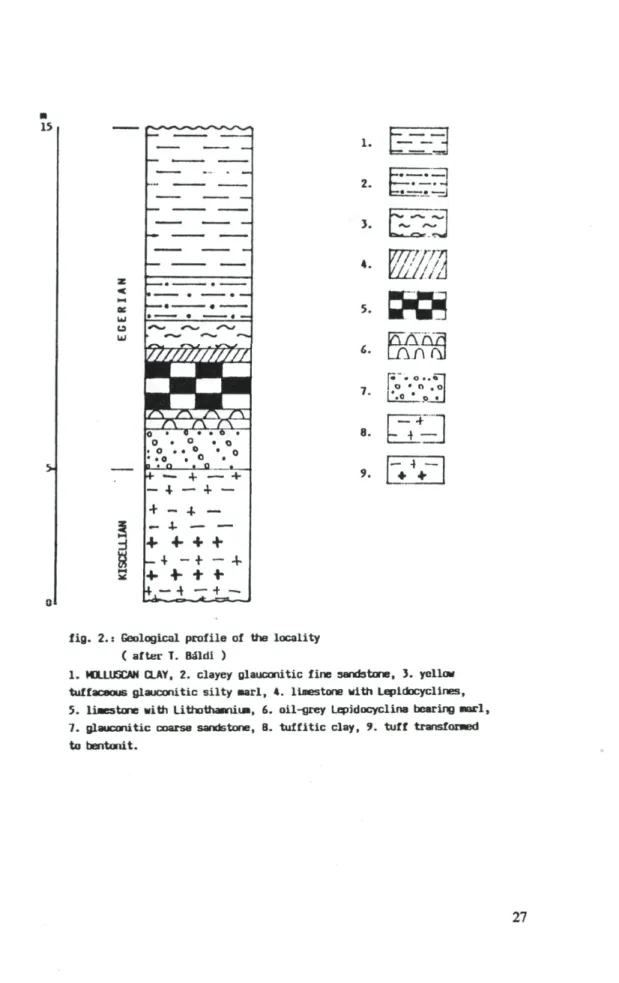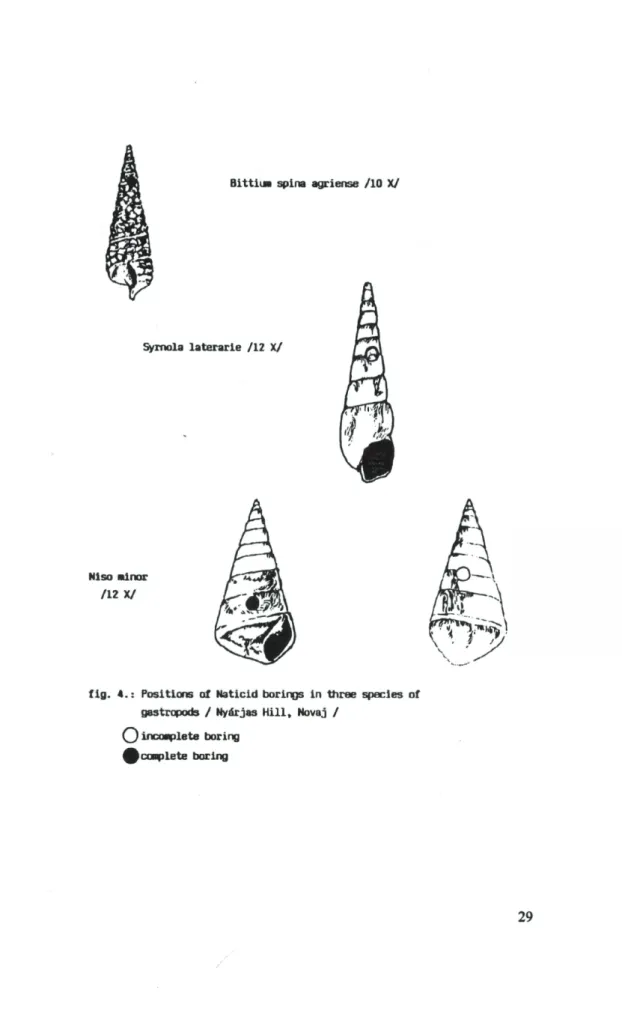DÁVID ÁRPÁD
CONTRIBUTION TO THE KNOWLEDGE OF THE TRACE FOSSILS FOUND ON THE MOLLUSCS IN
THE MOLLUSCAN CLAY OF NYÁRJAS HILL /NOVAJ, HUNGARY
ABSTRACT: The author examines the occurrence and distribution of trace fossils on the molluscs of the Molluscan Clay of Nyátjas Hill. There are four types of trace fossils have been found in the material collected at this locality.
INTRODUCTION: Of the several Upper Oligocene outcrops in the environs of Eger /North-Hungary/, the most complete one is the Nyárjas Hill at Novaj. This locality lies about five km, north of Novaj /Fig.:l/.
The Upper Oligocene layers of the outcrop are exposed in a 20 metres long and one meter deep ditch on the western slope of Nyárjas Hill /Fig.:2/. The molluscan clay beds of this succession contain well-preserved mollusc fauna in an exceptional richness.
The aim of my investigation has been to examine the number and distribution of trace fossils in the collected material.
METHODS: Fifteen kilograms of molluscan clay was collected from the locality. After drying, the sample was treated by hot water and peroxide of hydrogen. This material was washed out through a 0,5mm sieve. Finally, the molluscan remains were assorted from among the other fossils /e.g. Foraminifera, Decapoda, Echinoidea, Osteichthyes/.
21
Most of the molluscs were fragmentary, but also many complete specimens and specimens in cast preservation were found.
The complete shells and identifiable fragments were inspected for the presence of trace fossils. In the case of cast recognition of trace fossils is often uncertain and doubtful.
DESCRIPTION: The molluscan remains of the sample consist of 275 individuals representing 32 species /Table 1/. Trace fossils can be seen on the tests of 13 individuals of 8 species. 4.7 percent of individuals and 25 percent of species bear trace fossils in the collected material. 87.5 percent of the species bearing trace fossils were the member of the infauna. Distribution of trace fossils according to feeding habits of mollusc spccies is the following:
suspension feeders: 62.5 percent scavengers and predators: 12.5 percent
parasites: 25.0 percent
The 15 pieces of trace fossils can be assigned to four types /Table 2/.
A fragmentary specimen of Caduhts graeilina bears characteristic traces of fungal boring /Plate I, Fig. 1/. Cresentic shape of a presumably bite trace is observable on the margine of a Crassatella bosqueti minor valve.
There is a fragment of a Fhtbellipecten burdigalensis right valve with a complete muricid boring. The characteristic cylindrical borehole can be seen between two furrows at the margin /Plate I, Fig.2/.
12 naticid boreholes can be found in the shells of 10 specimens of six species.
The number of complete boreholes is eight. While the number of incomplete boreholes is four. There are fiveCrassatella hosqueti minor valves which bear a single naticid boring. Among the incomplete boreholes two can be seen is the right valve of a Corhula gihha /Fig.3/, /Plate II, Fig. 1. 2./. A specimen of IViso minor bears traces of multiple predation, too /Plate III. Fig. 1. 2. /. A complete and an incomplete boreholes can be seen on its test /Fig. 4./.
22
CONCLUSION: From an examination the occurrence and distribution of trace fossils on the shells of the molluscs of the Molluscan Clay of Nyáijas Hill it is possible to reconstruct food chains, to give more detailed picture of the trophic levels in the fossil community. As it is shown by the results of these preliminary examinations it is worth continuing the investigations at this locality.
LITERATURE CITED
1. Báldi, T. /1973/: Mollusc fauna of the Hungarian Upper Oligocene /Egerian/ Akadémiai Kiadó, Budapest, 511 p.
2. Báldi, T. /1986/: Mid-Tertiary Stratigraphy and Paleographic Evolution of Hungary Akladémiai Kiadó, Budapest, 201 p.
3. Dávid, Á. /1991/: New Paleoecological Observations on the Shells of Upper-Oligocene Molluscs /Wind Brickyard, Eger, Hungary/
(in Hungarian) Malakológiai Tájékoztató, 9. 12-14 pp.
4. Kitchell, J. A. et al. /1986/: Anomalies in Naticid Predatory Behavior: a Critique and Experimental Observations Malaco- logica, 27(2): 291-298 pp.
23
LIST OF SPECIES, NYÁRJAS HILL
Table 1.
1. Yoldia raulini 1*
2. Glycymeris sp. 1
3. Limopsis anomala 2
4. Flabellipecten burdigalensis 6
5. Chlamys csepreghymeznericsea 8
6. Astarte gracilis degrangei 4
7. Crassatella bosqueti minor 25
8. Cardita cf. ruginosa 3
9. Cavilucina droueti schlocnbachi 1
10. Cardium sp. 14
11. Venus multilamella 3
12. Angulus posterus 15
13. Corbula gibba 1
14. Turritella sp. 1
15. Architectonica mariae 1
16. Bittium spina agricnse 11
17. Cerithiella sp. 3
18. Natica millcpunctata tigrina 1
19. Hinia schlotheimi 12
20. Aquilofusus loczyi 1
21. Olivella clavula vindobonensis 1
22. Turricula leganyii 2
23. Niso minor 4
24. Turbonil la sp. 6
25. Melanella spina 1
26. M. naumanni depressosuturata 4
27. Syrnola laterariae 4
28. Ringicula auriculata paulucciae 7
29. Cylichna cylindracea raulini 5
30. Dentalium simplex 7
31. Fustiaria taurogracilis 10
32. Cadulus gracilina 9
Total: 275
* number of individuals
24
TABLE2. TYPES AND DISTRIBUTION OF TRACE FOSSILS ON THE MOLLUSCS OF THE MOLLUSCAN CLAY OFNYÁRJASHILL, NOVAJ LIST OF SPECIESBEARING TRACE FOSSILSHABITATFEEDING HABITSNTABCD FLABELLIPECTEN BURDIGALENS1SEPIFAUNALSUSPENSION FEEDER6/1X CRASSATELLABOSQUET1 MINOR1NFAUNALSUSPENSION FEEDER25/6XX CARD1UMSP.INFAUNALSUSPENSION FEEDER14/1X CORBULAINFAUNALSUSPENSION FEEDER1/1X B1TT1UM SPINAINFAUNALSUSPENSION FEEDER112/1X N1SO MINORINFAUNALPARASITE4/1X SYRNOLALATERAR1TEINFAUNALPARASITE4/1X CADULUSINFAUNALPREDATOR9/1X NT-number of individuals/number of individuals bearing trace fossil A: fungal boring, B: presumed bite traces, C: Muricid boring, D: Naticid boring K>
fig.1.:Mapsketchof thelocality.
fig. 2.» Geological profile of the locality ( after T. Báldi )
1. MOLLUSCAN CLAY, 2. clayey glauconitic fine sandatone, 3. yellow tuffaceous glauconitic silty Marl, 4. limestone with Lepidocyclines, 5. liaestone with Lithothanniun, 6. oil-grey Lepidocyclina bearing narl, 7. glauconitic coarse sandstone, 8. tuffitic clay,9. tuff transforwed to bentonit.
C u i t u l a Qibba / 6 , 5 X/
flg. 3.: Positions of Naticid borings in three species of bivalves / Nyárjasa Hill, Novaj /
Q i n c c n p l e t e boring
^ c o m p l e t e boring
28
C r a s s a t e l l a b o s q u e t i minor / 1 0 X/
Cardiun s p . / 1 5 X/
Nlso Minor /12 X/
fig. 4.: Positions of Naticid borings in three species of gastropods / Nyárjas Hill, Novaj /
( 3 incomplete boring Aconplete boring
29
Symola laterarie /12 X/
Bittiun spina agriense /10 X/
PLATE III.
1. Fungal borings in Cadulus gracilina/1 IX/
2. Muricid boring in a fragment of a Flabellipecten burdigalensis valve n x i
30
PLATE II.
2. Two incomplete Naticid boreholes in Corbula gibba /1XI 1. Complete Naticid borehole in Cardium sp. /IIX/
PLATE III.
1. Typical Naticid borehole in Niso minor /15X/
2. Incomplete Naticid borehole in the above mentioned Niso minor specimen1X5X1
32

